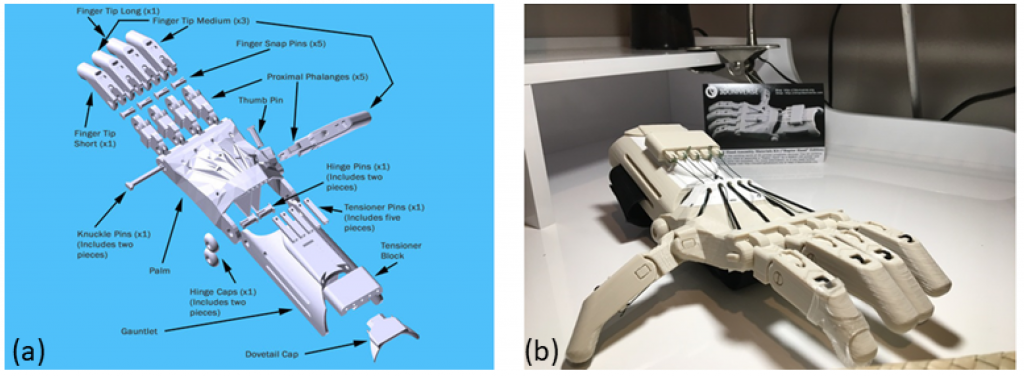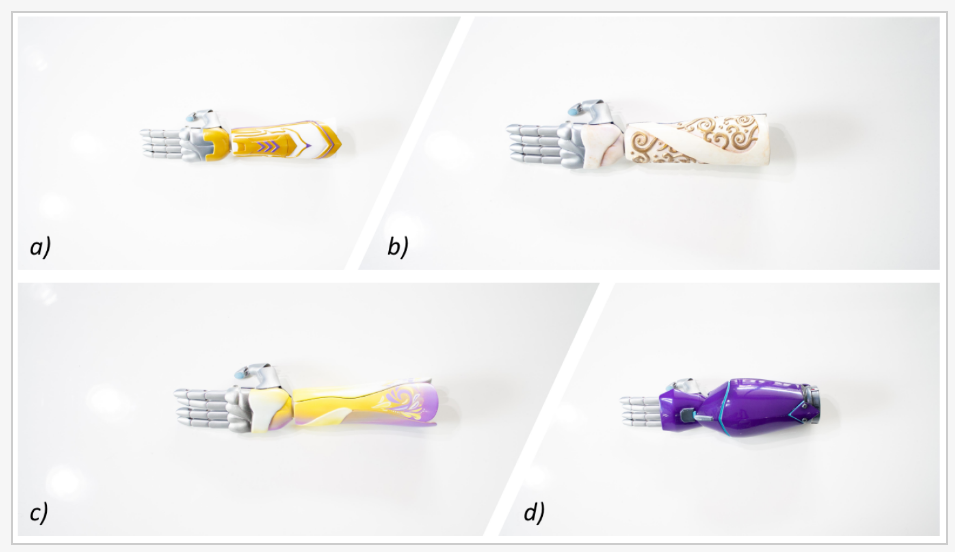US researchers from the University of Central Florida and Oregon Health and Science University have come together to review the history not only of prosthetics overall in the medical field but also to further inspect the transformation allowed by 3D printing. Contending that there are still many problems to be solved in prosthetics, the authors further explore children’s physical and emotional needs in the face of being born without or losing a limb later. Their central interest lies in new clinical trials, and in the generous—and growing—maker community.
Over 32,500 children in the US have endured amputations, according to the Centers for Disease Control and Prevention, with another 1,500 born with ‘upper-limb reductions’ annually (around 4 out of every 10,000 babies born). The authors state that many complexities arise with these limb amputations and reductions, and as a result, the use of prosthetics is still surprisingly limited. Users also tend to reject or put off applying for prosthetics due to:
- Lack of aesthetic design
- Weight
- Issues with insurance or medical help
- Lack of affordability overall
It may be hard to imagine the incredible level of self-consciousness in missing a limb—not to mention the challenges of wearing an artificial replacement in public. Because of obvious and completely understandable self-image dynamics, the researchers assert that aesthetics are a priority if users are realistically expected to wear their prosthetics long-term.
“Congenital limb loss patients are more likely to reject and forgo using a device as an adult, while females with acquired limb loss were more likely to reject devices than their male counterparts,” report the authors. “Prosthesis abandonment is a major issue in all populations and can be caused by many reasons. In the adult population, sensory feedback, appearance, function, control, comfort, and durability were all cited as key areas in need of study concerning prosthesis design and acceptance.”
Sadly, being ostracized is a very real issue, and while having a prosthetic means the potential for reducing some of the social issues, it can also have the opposite effect if it is ill-fitting or lacking enough design, both aesthetically and dynamically.
“Current trends in prostheses are to push normalization and reduce the level of stigma a user may encounter,” state the researchers.
As 3D printing has become increasingly more accessible and affordable, organizations and designers have begun working together within and outside of the US. The most well-known groups are:
- e-Nable (with many designs available on Thingiverse)
- Enable Community Foundation
- Robohand
- Limbitless Solutions

The Robohand assistive device, first made available for 3D printing globally via Thingiverse. (flickr Image credit from: FDA)
Prosthetics can be completely customized and made quickly, all truly at a fraction of the cost of traditional devices. Designs for children can be fun and colorful too, allowing them to be excited about wearing their new replacement limbs, rather than approaching them with trepidation and dread.
“These devices have reached new heights of accessibility for children all over the globe, made possible due to the availability of open-source customizable designs and new 3D printers used in schools, libraries, and even residences,” explain the authors.

The Raptor reloaded hand by Enable available for download via Thingiverse. (a) Exploded view of design and user assembly methods. (b) Completed assembly of device. (Image: Thingiverse)
Creating designs and printing them out has just been the tip of the iceberg as makers have endeavored to improve the world of prosthetics. Researchers, engineers, and talented designers have been responsible for integrating electronics into 3D printed prosthetics. Jon Schull of e-NABLE was behind the creation of body-powered forearms and hands driven by actuators.
Direct user participation – for example, children working with designers – has proved invaluable for success in creating prosthetics also, with ‘higher engagement’ promoting a more positive attitude about wearing a device. The researchers, and their design team, have also been participating in work that takes a more cooperative approach for creating customized bionic limbs that are more appealing due to interchangeable sleeves. These parts can be ‘artistically customized’ through a website, allowing for comparison, selection, and personalization with color and effects.
“This early interaction is anticipated to establish an emotional connection to the limb before the participant is fitted,” state the authors.

Example interactive web page for children to customize color and effect regions during the design process, and how user participation can be translated to (Right) the final design with artistic input from art team and production teams. Sleeve design made in partnership with Riot Games.
Creating these parts includes:
- 3D printing
- Prepping and priming
- Finishing, using techniques like those in the auto industry
- Painting
“Part of the design process offers the ability for different categories or ‘empowerment classes’ of interchangeable aesthetic sleeves. These classes are broken down into four individual groups, Warrior, Shadow, Ethereal, and Serenity,” state the authors.
“These classes are designed to represent different personalities linked to emotional affinities. Artists create these inspired 3D models to connect with these personalities, and in some cases, external artists representing characters have added designs to the catalog.”
The researchers have even developed interactive video games to teach users how to wear and use their prosthetics properly. The team has also created a new clinical trial concept, meant to run for a year, proposed in partnership with University of Central Florida and Oregon Health and Science University. It is designed for children in need of prosthetics between the ages of 6 and 17 who participate in four different segments.
“The outlook for using 3D printing manufacturing techniques and collaborative design is bright, with rapidly progressing iteration and designs that can better develop affinities for users,” concluded the researchers. “At this time, limited work has been reported involving sufficient power and clinical assessment. By designing and conducting novel clinical assessment of these electromyographic 3D printed bionic limbs with well-defined outcome metrics, this may lead to being able to add to the field and better capture the readiness for broader distribution.”
The world of 3D printing is full of surprises, and you never know what might catch on and completely disrupt one niche in a field where everyone involved is accustomed to the same traditional techniques that have been ongoing for decades. The medical field is a good example—and the myriad creation of 3D printed prosthetics is an even better one, from engineering replacement limbs for veterans, to changing the lives of children in India or Sierra Leone with innovative medical devices.

3D-printed electromyographic actuated limb device with interchangeable artistic covers from Limbitless Solutions at the University of Central Florida. (a) Warrior class, (b) Ethereal class, (c) Serenity class, and (d) Shadow class.
Subscribe to Our Email Newsletter
Stay up-to-date on all the latest news from the 3D printing industry and receive information and offers from third party vendors.
You May Also Like
Nylon 3D Printed Parts Made More Functional with Coatings & Colors
Parts 3D printed from polyamide (PA, Nylon) 12 using powder bed fusion (PBF) are a mainstay in the additive manufacturing (AM) industry. While post-finishing processes have improved the porosity of...
3DPOD Episode 193: Flow and What’s Possible in 3D Printing with Ricky Wildman, University of Nottingham
Ricky Wildman is working on 3D printing pills, but, as Professor of Multiphase Flow and Physics at Nottingham, he does a whole lot more. His research encompasses the characterization of...
3D Printing Webinar and Event Roundup: March 17, 2024
It’s another busy week of webinars and events, including SALMED 2024 and AM Forum in Berlin. Stratasys continues its in-person training and is offering two webinars, ASTM is holding a...
3D Printed Micro Antenna is 15% Smaller and 6X Lighter
Horizon Microtechnologies has achieved success in creating a high-frequency D-Band horn antenna through micro 3D printing. However, this achievement did not rely solely on 3D printing; it involved a combination...





























